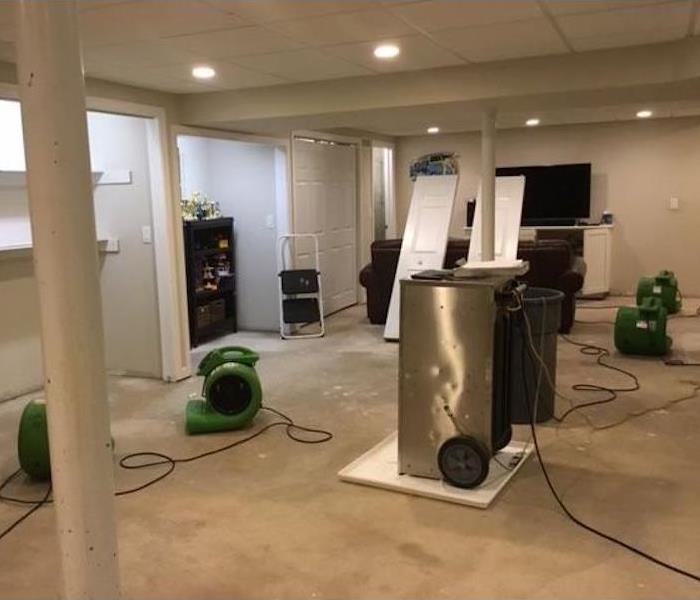What Tools Work Best for Basement Extractions?
10/28/2020 (Permalink)
Water in the basement of New Haven homes can be a challenge, but our SERVPRO team can help with advanced tools.
Water damages happening anywhere in your New Haven home can leave you with a dire need for immediate actions like extraction and drying. While many homeowners believe that water disasters can get resolved using conventional drying approaches like absorbing water with towels and mopping up the floors, this is rarely the case. Especially in more challenging areas of your home like the basement or attic, specific provisions are necessary to handle standing water and adequately dry the area to prevent secondary conditions like mold growth.
When you require water extraction from New Haven basements, this is not as straightforward as it might sound. For instance, you must often first consider the source of the damage to ensure that it has gotten sufficiently resolved before cleanup can be effective. Without identifying the source of basement flooding, you could only temporarily resolve the issue and leave the property vulnerable to continued damage. For substantial water damage in lower levels of the home, common culprits causing these concerns include:
- Flooding
- Water Heater Malfunctions
- Appliances Breaking
- Plumbing Ruptures / Pipes Freezing
How Soon Should Extraction Begin?
There are countless layers of mitigation and restoration required after substantial water disasters impact area homes. The sooner our technicians can become involved in this process, the less widespread and ruinous water exposure and saturation become. Standing water can often be one of the direst of these concerns, as penetration into materials like carpeting or hardwood in finished basements can damage more than the surface materials. With extraction begins such a vital element to the house after a water damage incident, it is often one of the first actions taken even before job scoping and thorough planning occurs.
What Tools Are Best for Basement Extractions?
Removing standing water from the basement often requires more care and consideration than property owners realize. Especially in situations where this lower level is finished and a livable space of the house, choosing the right extraction tool can reduce the destruction that many porous, sensitive structural elements face. Because we strive to have the industry-leading tools to manage every facet of water restoration, there are multiple extraction and water removal tools in our inventory to help with damaged basements, including:
- High-Pressure Pumps – Because of the basements distance from many of our stationary submersible pump options and the rise of the discharge lines to remove trapped water, high-pressure pumps can be the preferred choice for the basement and attic extraction needs.
- Electric Submersible Pumps – Electric submersible pumps are among the most heavily used water removal tools in our arsenal beyond wet vacuums. Because of their portability and continued operation through hours of use, these tools can quickly manage standing water concerns.
- Self-Priming Trash Pumps – Sometimes, especially in situations like flooding, debris and solids become a concern for the extractor. Self-priming trash pumps can move solids in the water and continue to eliminate standing water simultaneously.
- Wet Vacuums – Because of their portability and base for various attachments, wet vacuums are a common staple for extraction and water damage recovery in the basement of your home.
What Other Areas Must Get Inspected and Repaired?
Simply removing the water from the basement floors is not sufficient to eliminate the present threat after a water disaster. Other areas undoubtedly require attention, cleaning, and drying. Inspecting several areas of your home during the job scoping phase can reveal potential concerns with multiple building materials and structural elements, including:
- Subflooring/Joists – With finished floors, especially, water penetration can happen quickly. Also, damage to plumbing or moist conditions can have a disastrous effect on exposed joists for the main floor of your home if ceiling materials were not installed.
- Drywall - Both as ceiling and wall materials, drywall is among the most porous building components used in a finished basement. It rarely takes longer than 24 hours of direct exposure for these elements to become unsalvageable.
- Flooring – Whether it is vinyl plank flooring or carpeting, excess water can quickly overwhelm flooring material that isn't low-permeance like concrete.
Water damages to your basement are not uncommon, though swift action is recommended to limit the severity of these situations. When you have a finished lower level, the timeline is even shorter to begin efforts like extraction and drying. Our SERVPRO of New Haven team can help to make basement water loss events "Like it never even happened." Give us a call anytime at (203) 234-1100.






 24/7 Emergency Service
24/7 Emergency Service